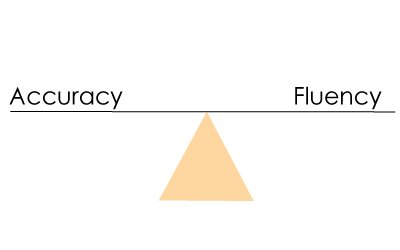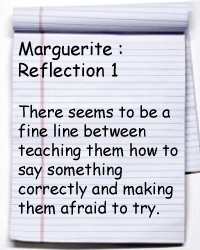 Communicative Competency: Accuracy vs. Fluency
Communicative Competency: Accuracy vs. Fluency
 Many teachers have difficulty defining where accuracy should be stressed over fluency and vice versa. In the case studies we see that our teacher friends want to correct their students so that they will be using the language correctly, but they also do not want to discourage students from trying by over-correcting. In Marguerite's case for example, she is unsure about which aspect of language is more important or desired by her students at the specific level she is teaching: fluency or accuracy? In this section we will discuss Communicative Competency and how understanding the learner’s communication needs is an important aspect for facilitating learning.
Many teachers have difficulty defining where accuracy should be stressed over fluency and vice versa. In the case studies we see that our teacher friends want to correct their students so that they will be using the language correctly, but they also do not want to discourage students from trying by over-correcting. In Marguerite's case for example, she is unsure about which aspect of language is more important or desired by her students at the specific level she is teaching: fluency or accuracy? In this section we will discuss Communicative Competency and how understanding the learner’s communication needs is an important aspect for facilitating learning. |
|
What is Communicative Competency?
 Communicative competency is the correlation between fluency and accuracy and refers to the ability of a speaker to communicate effectively in the language; this ability is based on more than just grammatical knowledge and the concept is derived from the general desire of language learners to be able to communicate proficiently, not to use the language exactly.
Communicative competency is the correlation between fluency and accuracy and refers to the ability of a speaker to communicate effectively in the language; this ability is based on more than just grammatical knowledge and the concept is derived from the general desire of language learners to be able to communicate proficiently, not to use the language exactly.
To be able to communicate in the TL fluently means that the speaker is comfortable using the language and can be reasonably understood by other speakers of the TL. This does not necessarily mean that the speaker is free of errors in their communication, but that the errors they make do not obstruct the message. Accuracy refers to the correctness of the language being produced by the speaker. Just because a speaker focuses on accuracy does not mean they will be capable of producing effective communication.
back to top
What are the areas of competency?
Communicative competency is made up of four competence areas: linguistic, sociolinguistic, discourse, and strategic.
Competence |
What is it asking? |
| Linguistic competence is knowing how to use the grammar, syntax, pronunciation and vocabulary of a language. | Linguistic competence asks: What words do I use? How do I put them into phrases and sentences? |
| Sociolinguistic competence is knowing how to use and respond to language appropriately, given the setting, the topic, and the relationships among the people communicating. | Sociolinguistic competence asks: Which words and phrases fit this setting and this topic? How can I express a specific attitude (courtesy, authority, friendliness, respect) when I need to? How do I know what attitude another person is expressing? |
| Discourse competence is knowing how to interpret the larger context and how to construct longer stretches of language so that the parts make up a coherent whole. | Discourse competence asks: How are words, phrases and sentences put together to create conversations, presentations, invitations, email messages, reports, newspaper articles? |
| Strategic competence is knowing how to recognize and repair communication breakdowns, how to work around gaps in one’s knowledge of the language, and how to learn more about the language and in the context. | Strategic competence asks: How do I know when I’ve misunderstood or when someone has misunderstood me? What do I say then? How can I express my ideas if I don’t know the name of something or the right verb form to use? |
 |
In your opinion, which of these competencies is the most important? Does it depend on the stage of learning? |
back to top
How can I apply this knowledge in my classroom?
Communicative competency (or accuracy vs. fluency) is important during the GIVING IT stage of B-SLIM where teacher needs to decide WHAT to teach the learners.
In the early stages of language learning, it is believed that the focus should be on learners being able to make themselves understood, using their current proficiency to the fullest. They should try to avoid confusion in the message (due to faulty pronunciation, grammar, or vocabulary); to avoid offending communication partners (due to socially inappropriate style); and to use strategies for recognizing and managing communication breakdowns.
To find out more about what LEARNERS perceive to be most important at different stages of learning a new language visit Higgs' Graph of Learner Needs.
What activities can I plan to encourage communicative competency?
Communicative language tests are those which make an effort to test language in a way that reflects the way that language is used in real communication. It is, of course, not always possible to make language tests communicative, but it may often be possible to give them communicative elements. This can have other beneficial effects; if students are encouraged to study for more communicative tasks, this can only have a positive effect on their language learning.
Click here for more information on Communicative Activities.
 |
Test your knowledge of Communicative Competency with this quiz. |

A history and Overview of Communicative Competence.
http://www.ne.jp/asahi/kurazumi/peon/ccmodel.html
Teaching for Communicative Competence
http://www.ncsall.net/?id=739










